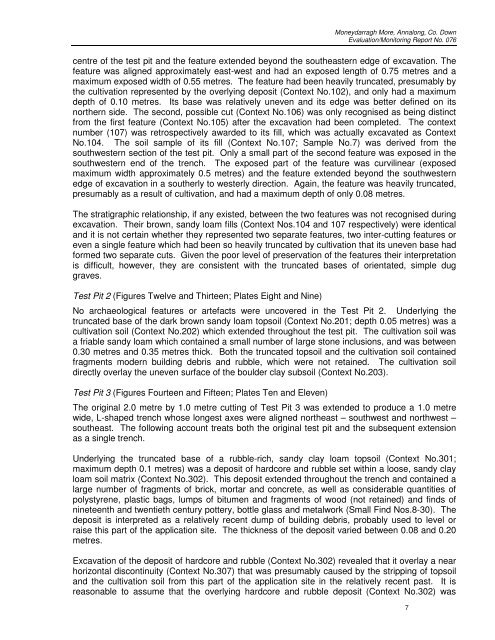Moneydarragh More - Queen's University Belfast
Moneydarragh More - Queen's University Belfast
Moneydarragh More - Queen's University Belfast
Create successful ePaper yourself
Turn your PDF publications into a flip-book with our unique Google optimized e-Paper software.
<strong>Moneydarragh</strong> <strong>More</strong>, Annalong, Co. Down<br />
Evaluation/Monitoring Report No. 076<br />
centre of the test pit and the feature extended beyond the southeastern edge of excavation. The<br />
feature was aligned approximately east-west and had an exposed length of 0.75 metres and a<br />
maximum exposed width of 0.55 metres. The feature had been heavily truncated, presumably by<br />
the cultivation represented by the overlying deposit (Context No.102), and only had a maximum<br />
depth of 0.10 metres. Its base was relatively uneven and its edge was better defined on its<br />
northern side. The second, possible cut (Context No.106) was only recognised as being distinct<br />
from the first feature (Context No.105) after the excavation had been completed. The context<br />
number (107) was retrospectively awarded to its fill, which was actually excavated as Context<br />
No.104. The soil sample of its fill (Context No.107; Sample No.7) was derived from the<br />
southwestern section of the test pit. Only a small part of the second feature was exposed in the<br />
southwestern end of the trench. The exposed part of the feature was curvilinear (exposed<br />
maximum width approximately 0.5 metres) and the feature extended beyond the southwestern<br />
edge of excavation in a southerly to westerly direction. Again, the feature was heavily truncated,<br />
presumably as a result of cultivation, and had a maximum depth of only 0.08 metres.<br />
The stratigraphic relationship, if any existed, between the two features was not recognised during<br />
excavation. Their brown, sandy loam fills (Context Nos.104 and 107 respectively) were identical<br />
and it is not certain whether they represented two separate features, two inter-cutting features or<br />
even a single feature which had been so heavily truncated by cultivation that its uneven base had<br />
formed two separate cuts. Given the poor level of preservation of the features their interpretation<br />
is difficult, however, they are consistent with the truncated bases of orientated, simple dug<br />
graves.<br />
Test Pit 2 (Figures Twelve and Thirteen; Plates Eight and Nine)<br />
No archaeological features or artefacts were uncovered in the Test Pit 2. Underlying the<br />
truncated base of the dark brown sandy loam topsoil (Context No.201; depth 0.05 metres) was a<br />
cultivation soil (Context No.202) which extended throughout the test pit. The cultivation soil was<br />
a friable sandy loam which contained a small number of large stone inclusions, and was between<br />
0.30 metres and 0.35 metres thick. Both the truncated topsoil and the cultivation soil contained<br />
fragments modern building debris and rubble, which were not retained. The cultivation soil<br />
directly overlay the uneven surface of the boulder clay subsoil (Context No.203).<br />
Test Pit 3 (Figures Fourteen and Fifteen; Plates Ten and Eleven)<br />
The original 2.0 metre by 1.0 metre cutting of Test Pit 3 was extended to produce a 1.0 metre<br />
wide, L-shaped trench whose longest axes were aligned northeast – southwest and northwest –<br />
southeast. The following account treats both the original test pit and the subsequent extension<br />
as a single trench.<br />
Underlying the truncated base of a rubble-rich, sandy clay loam topsoil (Context No.301;<br />
maximum depth 0.1 metres) was a deposit of hardcore and rubble set within a loose, sandy clay<br />
loam soil matrix (Context No.302). This deposit extended throughout the trench and contained a<br />
large number of fragments of brick, mortar and concrete, as well as considerable quantities of<br />
polystyrene, plastic bags, lumps of bitumen and fragments of wood (not retained) and finds of<br />
nineteenth and twentieth century pottery, bottle glass and metalwork (Small Find Nos.8-30). The<br />
deposit is interpreted as a relatively recent dump of building debris, probably used to level or<br />
raise this part of the application site. The thickness of the deposit varied between 0.08 and 0.20<br />
metres.<br />
Excavation of the deposit of hardcore and rubble (Context No.302) revealed that it overlay a near<br />
horizontal discontinuity (Context No.307) that was presumably caused by the stripping of topsoil<br />
and the cultivation soil from this part of the application site in the relatively recent past. It is<br />
reasonable to assume that the overlying hardcore and rubble deposit (Context No.302) was<br />
7

















